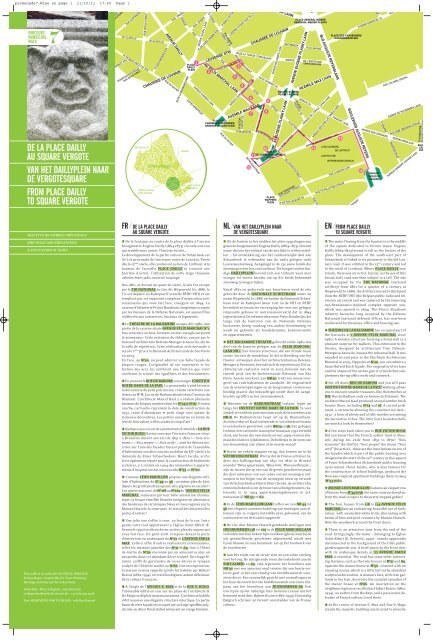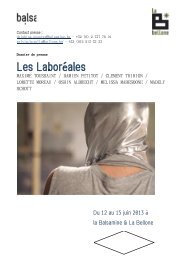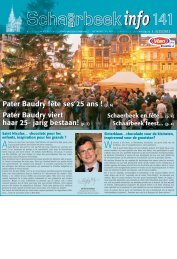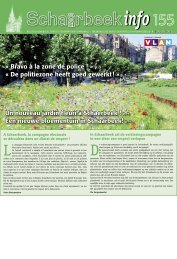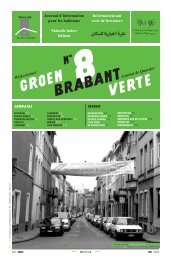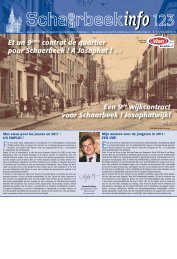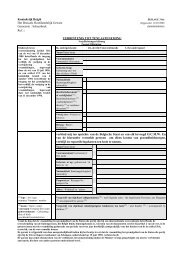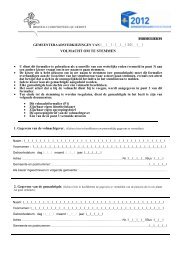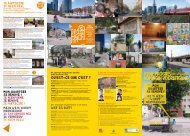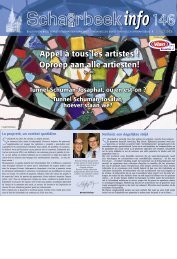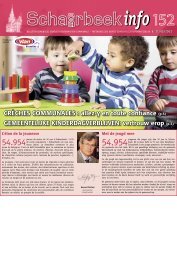Download de wandeling (pdf) - Schaerbeek
Download de wandeling (pdf) - Schaerbeek
Download de wandeling (pdf) - Schaerbeek
You also want an ePaper? Increase the reach of your titles
YUMPU automatically turns print PDFs into web optimized ePapers that Google loves.
promena<strong>de</strong>7:Mise en page 1 11/10/11 17:50 Page 1<br />
PARCOURS<br />
WANDELING<br />
WALK<br />
7<br />
DE LA PLACE DAILLY<br />
AU SQUARE VERGOTE<br />
VAN HET DAILLYPLEIN NAAR<br />
DE VERGOTESQUARE<br />
FROM PLACE DAILLY<br />
TO SQUARE VERGOTE<br />
PALETTES DE PIERRES PRÉCIEUSES<br />
RIJK PALET AAN EDELSTENEN<br />
A SUCCESSION OF GEMS<br />
This walk is an initiative by CÉCILE JODOGNE,<br />
Acting Mayor, responsible for Town Planning,<br />
Heritage and Tourism for <strong>Schaerbeek</strong><br />
Town hall – Place Colignon, 1030 Brussels<br />
cjodogne@schaerbeek.irisnet.be – +32 (0)2 244 7028<br />
Text: GENEVIÈVE VAN TICHELEN - asbl Bus Bavard<br />
BERT D<br />
UR STRAAT<br />
VERBIST STR.<br />
RUE ALEXANDRE<br />
AV CLAYS LN<br />
RUE DE LA CIBLE<br />
SCHIETSCHIJFSTRAAT<br />
RUE ARTAN STRAAT<br />
R.THOMAS VINCOTTE STR.<br />
BRUXELLES<br />
AV CLAYS LN<br />
R LEON MIGNON STR<br />
RUE DU NOYER<br />
GRANDE<br />
RUE FRANCOIS<br />
AVENUE DAILLY<br />
CHAUSSEE DE LOUVAIN<br />
SAINT-JOSSE-<br />
TEN-NOODE<br />
SCHAERBEEK<br />
FR / DE LA PLACE DAILLY<br />
AU SQUARE VERGOTE<br />
T<br />
S<br />
AV.DE LA BRABANCONNE<br />
EVERE<br />
RUE<br />
RUE<br />
PLACE<br />
DAILLY<br />
PLEIN<br />
1<br />
AVENUE CHARBO LAAN<br />
NOTELAARSTRAAT<br />
WOLUWE-SAINT-<br />
LAMBERT<br />
JOSEPH<br />
AVENUE CHAZAL LAAN<br />
TTE STRAAT<br />
CO<br />
R JACQUES JANSEN STR<br />
De la fontaine, au centre <strong>de</strong> la place dédiée à l’ancien<br />
bourgmestre Eugène Dailly (1864-1873) s’écoule une eau<br />
qui semble nous conter l’histoire du site…<br />
Le développement <strong>de</strong> la partie sud-est <strong>de</strong> Schærbeek est<br />
lié à la proximité <strong>de</strong> l’ancienne route <strong>de</strong> Louvain. Pavée<br />
dès le 15ème 1<br />
siècle, elle conduisait au bois <strong>de</strong> Linthout. A la<br />
hauteur <strong>de</strong> l’actuelle PLACE DAILLY se trouvait une<br />
barrière d’octroi, l’utilisation <strong>de</strong> cette large chaussée<br />
arborée étant jadis soumise au péage.<br />
Dès 1861, et durant un quart <strong>de</strong> siècle, le site fut occupé<br />
par le TIR NATIONAL au lieu dit Weyenveld. En 1886, le<br />
Tir est déplacé au Kattepoel (l’actuelle RTBF/VRT) et est<br />
remplacé par cet imposant complexe d’inspiration néorenaissance<br />
qui vous fait face, inauguré en 1894. La<br />
caserne d’infanterie Prince Baudouin, longtemps occupée<br />
par les bureaux <strong>de</strong> la Défense Nationale, est aujourd’hui<br />
réaffectée aux commerces, bureaux et logements.<br />
Le THÉÂTRE DE LA BALSAMINE occupe, dès 1980, une<br />
partie <strong>de</strong> la caserne située AVENUE FÉLIX MARCHAL N°1.<br />
Une structure en bois, formant un mur aveugle surprend<br />
le promeneur. Cette extension du théâtre, conçue par le<br />
bureau d’architecture Deleuze-Metzger & Associés, abrite<br />
la salle <strong>de</strong> répétition. Cette réalisation architecturale a<br />
reçu le 2ème 2<br />
prix à la Biennale Architecturale <strong>de</strong> Sao Paolo<br />
en 2003.<br />
En face, au N°20, on peut admirer une belle faça<strong>de</strong> <strong>de</strong><br />
briques rouges. L’originalité <strong>de</strong> ses ouvertures et les<br />
formes <strong>de</strong>s arcs lui confèrent une finition que vient<br />
confirmer le travail <strong>de</strong>s sgraffites et <strong>de</strong>s ferronneries.<br />
3 En prenant la RUE DU RADIUM, vous longez L’INSTITUT<br />
NOTRE DAME DE LA PAIX. La promena<strong>de</strong> à pied favorise<br />
la découverte du petit patrimoine, comme cette boîte aux<br />
lettres au N° 8. La rue du Radium aboutit dans l’avenue du<br />
Diamant. L’architecte Marcel Kaal y a réalisé plusieurs<br />
maisons <strong>de</strong> briques sombres dont les N°14 et N°16. Fronton<br />
courbe, cartouche reprenant la date <strong>de</strong> construction <strong>de</strong><br />
1932, corne d’abondance et petit singe sont autant <strong>de</strong><br />
richesses décoratives. Les petites sonnettes en forme <strong>de</strong><br />
tête <strong>de</strong> lion valent à elles seules le coup d’œil !<br />
Quelques pas en arrière permettent d’atteindre LA RUE<br />
VICTOR HUGO. Saviez-vous que l’écrivain français vécut<br />
à Bruxelles durant son exil <strong>de</strong> 1851 à 1870 ? « Sois économe<br />
», « Sois propre », « Sois actif »… sont les <strong>de</strong>vises inscrites<br />
sur l’une <strong>de</strong>s faça<strong>de</strong>s faisant partie <strong>de</strong> l’ensemble<br />
d’habitations sociales conçues au début du XXe 4<br />
siècle à la<br />
<strong>de</strong>man<strong>de</strong> du Foyer <strong>Schaerbeek</strong>ois. Henri Jacobs, architecte<br />
également réputé pour la construction <strong>de</strong> bâtiments<br />
scolaires, y a réalisé en 1904 <strong>de</strong>s immeubles à appartements<br />
d’inspiration Art nouveau (du N°53 au N° 61).<br />
5 L’avenue LÉON MAHILLON propose une élégante enfila<strong>de</strong><br />
d’habitations du N° 44 au 56 : un même plan <strong>de</strong> bâti,<br />
<strong>de</strong>puis les gratte pieds jusqu’aux jolis pignons en escalier !<br />
Les quatre maisons, du N° 118 au N°124 <strong>de</strong> l’AVENUE FÉLIX<br />
MARCHAL, séduisent par leur belle animation chromatique,<br />
la brique émaillée blanche intégrant en alternance<br />
<strong>de</strong>s ban<strong>de</strong>aux <strong>de</strong> céramiques bleus et roses signées par la<br />
Maison Hasselt. A remarquer : le travail <strong>de</strong>s boiseries <strong>de</strong>s<br />
portes d’entrée !<br />
7 Une jolie vue s’offre à vous au bout <strong>de</strong> la rue. Intrigante,<br />
cette tour appartenant à l’église Saint-Albert (E.<br />
Serneels 1930) se décroche en arrière plan du square qui<br />
vous fait face. Un petit arrêt s’impose <strong>de</strong>vant la porte<br />
d’entrée tout en arabesques du N°77 <strong>de</strong> L’AVENUE EMILE<br />
MAX. Celle-ci offre d’autres réalisations intéressantes,<br />
telles les maisons jumelles <strong>de</strong>s N°71 et 69, face à l’hôtel<br />
<strong>de</strong> maître du N°50 couronné par un amusant oculus un<br />
peu perdu dans cet abondant décor sculpté. Un visage féminin<br />
coiffé <strong>de</strong> guirlan<strong>de</strong>s <strong>de</strong> roses décore le tympan<br />
sculpté <strong>de</strong> l’hôtel <strong>de</strong> maître au N°66. Une inscription sur<br />
la maison voisine rappelle qu’elle fut habitée par Hubert<br />
Krains (1862-1934), écrivain hesbignon, ar<strong>de</strong>nt défenseur<br />
<strong>de</strong> la culture française.<br />
8 A l’angle <strong>de</strong> l’AVENUE E. MAX et <strong>de</strong> la RUE V. HUGO,<br />
l’immeuble édifié en 1911 sur les plans <strong>de</strong> l’architecte O.<br />
De Paepe se déploie majestueusement. L’architecte habille<br />
d’Art nouveau une élégante structure éclectique. La partie<br />
haute <strong>de</strong> cette faça<strong>de</strong> est occupée par un large sgraffite polychrome<br />
au décor floral stylisé entourant un visage féminin.<br />
R EMILE WITTMA<br />
LAMBIOTTE Str<br />
LEUVENSE<br />
L<br />
STW<br />
RUE<br />
R.AUGUSTE<br />
AV. AV AA V FELI FELIX MARCHAL LAAN<br />
2<br />
R RR DU DU RADIUM RADIUM DIUM UM STR STR STR STR<br />
PLACE DES<br />
CHASSEURS ARDENNAIS<br />
ARDENSE JAGERS PLEIN<br />
RUE DU NOYER<br />
LUZERNE STRAAT RUE DE LA LU<br />
AV.DE LA TOPAZE TOPAASLAAN<br />
DIAMANT<br />
DU DU<br />
AVENUE NUE<br />
3<br />
AVENUE LEON N MAHILLON MAHILLON LAAN<br />
R VICTOR<br />
Str<br />
OUDART<br />
R RASSON Str<br />
NOTELAARSTRAAT<br />
STRAAT<br />
PLACE<br />
WAPPERS<br />
PLEIN<br />
GIER LAAN<br />
CHAUSSEE DE LOUVAIN<br />
HUGO<br />
AVENUE AVENUE A MILCAMPS MILCAMPS LAAN LAAN<br />
AV.EUGENE EU PLASKY LAAN<br />
PLAC PLACE LAC<br />
DE JAMBLINNE AMBLINNE MBL DE MEU MEUX<br />
PLEIN EIN<br />
AVENUE<br />
VICTOR VICTOR HUGO Str<br />
4<br />
5<br />
6<br />
7<br />
AV.DU DIAMANT LN<br />
9<br />
8<br />
AVENUE MILCAMPS LAAN<br />
SAFFIERSTR<br />
SQUARE EUGENE<br />
PLASKY SQUARE<br />
AV.DE AV A VV .DE L'O L'OPALE PALE PP<br />
AVENUE EUGENE PLASKY LAAN<br />
R LEON<br />
FREDERIC Str<br />
RUE THEODORE<br />
ROOSEVELT STRAAT<br />
AVENUE DU<br />
R DU SAPHIR<br />
AV.EMILE MAX X LAAN LAAN AN AN<br />
AV.EMILE MAX LAAN<br />
12<br />
11<br />
RASSON<br />
RASSON S<br />
R R<br />
Str St<br />
10<br />
SS r<br />
NL/VAN HET DAILLYPLEIN NAAR<br />
DE VERGOTESQUARE<br />
R VICTOR HUGO Str<br />
DE LINTHOUTSTRAAT<br />
R VICTOR LEFEVRE Str<br />
S<br />
PLACE GENERAL MEISER<br />
GENERAAL MEISER PLAATS<br />
DE L'EMERAUDE<br />
SMARAGDLAAN<br />
1 Uit <strong>de</strong> fontein in het mid<strong>de</strong>n het plein opgedragen aan<br />
gewezen burgemeester Eugène Dailly (1864-1873) stroomt<br />
water dat ons het verhaal van <strong>de</strong> site lijkt te willen vertellen<br />
... De ontwikkeling van het zuidoostelijke <strong>de</strong>el van<br />
Schaarbeek is verbon<strong>de</strong>n aan <strong>de</strong> nabij gelegen ou<strong>de</strong><br />
Leuvensesteenweg. Aangelegd in <strong>de</strong> 15e eeuw leid<strong>de</strong> die<br />
steenweg tot het bos van Linthout. Ter hoogte van het huidige<br />
DAILLYPLEIN bevond zich een tolboom waar men<br />
vroeger tol moest betalen om op die bre<strong>de</strong> beboom<strong>de</strong><br />
steenweg te mogen rij<strong>de</strong>n.<br />
Vanaf 1861 en geduren<strong>de</strong> een kwarteeuw werd <strong>de</strong> site<br />
gebruikt door <strong>de</strong> NATIONALE SCHIETBAAN on<strong>de</strong>r <strong>de</strong><br />
naam Weyenveld. In 1886 verhuis<strong>de</strong> <strong>de</strong> Nationale Schietbaan<br />
naar <strong>de</strong> Kattepoel (waar zich nu <strong>de</strong> VRT en RTBF<br />
bevin<strong>de</strong>n) en kwam ter vervanging het voor ons gelegen<br />
imposante gebouw in neorenaissancestijl dat in 1894<br />
ingewijd werd. De infanteriekazerne Prins Bou<strong>de</strong>wijn, die<br />
lange tijd <strong>de</strong> kantoren van <strong>de</strong> Nationale Defensie<br />
huisvestte, kreeg vandaag een an<strong>de</strong>re bestemming en<br />
wordt nu gebruikt als han<strong>de</strong>lsruimte, kantoorruimte<br />
en appartementen.<br />
2 HET BALSAMINE THEATER gebruikt sinds 1980 een<br />
<strong>de</strong>el van <strong>de</strong> kazerne gelegen aan <strong>de</strong> FELIX MARCHAL-<br />
LAAN NR 1. Een houten structuur, die een blin<strong>de</strong> muur<br />
vormt, verrast <strong>de</strong> wan<strong>de</strong>laar. In die uitbreiding van het<br />
theater, ontworpen door het architectenbureau Deleuze-<br />
Metzger & Vennoten, bevindt zich <strong>de</strong> repetitiezaal. Die architecturale<br />
realisatie werd in 2003 beloond met <strong>de</strong><br />
twee<strong>de</strong> prijs van <strong>de</strong> Architecturale Biënnale van São<br />
Paolo. Aan <strong>de</strong> overkant, aan NR 20, trekt een mooie voorgevel<br />
van ro<strong>de</strong> bakstenen <strong>de</strong> aandacht. De originaliteit<br />
van <strong>de</strong> vensteropeningen en <strong>de</strong> boogvormen vormen een<br />
beeldig plaatje dat bekrachtigd wordt door <strong>de</strong> aangebrachte<br />
sgraffiti en het siersmeedwerk.<br />
3 Wanneer we <strong>de</strong> RADIUMSTRAAT inslaan, lopen we<br />
langs het INSTITUT NOTRE DAME DE LA PAIX. Te voet<br />
ont<strong>de</strong>k je een klein patrimonium zoals <strong>de</strong> brievenbus aan<br />
NR 8. De Radiumstraat loopt uit op <strong>de</strong> Diamantlaan.<br />
Architect Marcel Kaal realiseer<strong>de</strong> er verschei<strong>de</strong>ne huizen<br />
in een donkere gevelsteen zoals NR 14 en 16. Een gebogen<br />
fronton, een cartouche waarop het bouwjaar 1932 vermeld<br />
staat, een hoorn <strong>de</strong>s overvloeds en een aapje vormen allemaal<br />
<strong>de</strong>coratieve rijkdommen. De belletjes in <strong>de</strong> vorm van<br />
een leeuwenkop zijn alleen al <strong>de</strong> moeite waard!<br />
4 Keren we enkele stappen terug, dan komen we in <strong>de</strong><br />
VICTOR HUGOSTRAAT. Wist je dat <strong>de</strong> Franse schrijver tij<strong>de</strong>ns<br />
zijn ballingschap van 1851 tot 1870 in Brussel<br />
woon<strong>de</strong>? ‘Wees spaarzaam, ‘Wees rein’, ‘Wees werkzaam’…<br />
zijn <strong>de</strong> leuzen die op een van <strong>de</strong> gevels geschreven staan<br />
die <strong>de</strong>el uitmaken van een reeks sociale woningen ontworpen<br />
in het begin van <strong>de</strong> twintigste eeuw op verzoek<br />
van De Schaarbeekse Haard. Henri Jacobs, <strong>de</strong> architect die<br />
eveneens bekend is om <strong>de</strong> bouw van schoolgebouwen, realiseer<strong>de</strong><br />
er in 1904 appartementsgebouwen in artnouveaustijl<br />
(NR 53 tot 61).<br />
5 In <strong>de</strong> LÉON MAHILLONLAAN treffen we van NR 44 tot<br />
56 een elegante aaneenschakeling van woningen aan: allemaal<br />
zijn ze volgens hetzelf<strong>de</strong> plan gebouwd, van <strong>de</strong><br />
voetroosters tot <strong>de</strong> fraaie trapgevels!<br />
6 De vier door Maison Hasselt geteken<strong>de</strong> woningen met<br />
HUISNUMMERS 118 tot 124 in <strong>de</strong> FÉLIX MARCHALLAAN<br />
verlei<strong>de</strong>n met hun bekoorlijke veelkeurigheid, waarbij <strong>de</strong><br />
wit geëmailleer<strong>de</strong> gevelsteen afgewisseld wordt met<br />
lijnen blauwe en roze keramiek. Let op het houtwerk van<br />
<strong>de</strong> voor<strong>de</strong>uren!<br />
7 Aan het ein<strong>de</strong> van <strong>de</strong> straat zien we een echte streling<br />
voor het oog. De intrigeren<strong>de</strong> toren die toebehoort aan <strong>de</strong><br />
SINT-ALBER 1 en 69, vlak tegenover het herenhuis aan<br />
NR 50 met een amusant rond venster dat een beetje verloren<br />
gaat in het overvloedig van beeldhouwwerk voorziene<br />
<strong>de</strong>cor. Een vrouwelijk gezicht met rozenslingers in<br />
het haar <strong>de</strong>coreert het van beeldhouwwerk voorziene timpaan<br />
van het herenhuis aan HUISNUMMER 66. Een<br />
inscriptie op het naburige huis herinnert eraan dat het<br />
bewoond werd door Hubert Krains (1862-1934), Franstalig<br />
Belgisch schrijver en fervent voorstan<strong>de</strong>r van <strong>de</strong> Franse<br />
cultuur.<br />
AVENUE ADOLPHE LACOMBLE LAAN<br />
PLACE DES CARABINIERS<br />
KARABINIERSPLEIN<br />
CITE OUVRIERE<br />
DE LINTHOUT<br />
LINTHOUTSE<br />
DIAMANT LAAN<br />
AVENUE NUE DE ROODEBEEK ROODEBEEK LAAN LAAN<br />
RUE DE<br />
BLD.AUGUSTE REYERSLAAN<br />
AVENUE DE L'OPALE OPAALLAAN<br />
13<br />
14<br />
WERKMANSWOONWIJK<br />
RUE G.GRATRY STR<br />
RUE FR.PELLETIER STRAAT<br />
BOULEVARD AUGUSTE REYERS<br />
STRAAT<br />
RAAT<br />
R HENRI EVENPOEL Str<br />
15<br />
EN/FROM PLACE DAILLY<br />
TO SQUARE VERGOTE<br />
AVENUE DES CERISIERS<br />
SQUARE<br />
VERGOTE<br />
SQUARE<br />
R KNAPEN<br />
RUE H<br />
RUE COLONEL BOURG<br />
AVENUE DE ROODEBEEK LAAN<br />
RUE AIME SMEKENS STRAAT<br />
KERSELARENLAAN<br />
KNAPENSTRAAT<br />
R W DEGOUVE<br />
DE<br />
NUNCQUES<br />
STR<br />
SQUA<br />
LEV<br />
AVENUE HERBERT HOOVER LAAN PLE<br />
The water flowing from the fountain in the middle<br />
of the square <strong>de</strong>dicated to former mayor Eugène<br />
Dailly (1864-1873) seems to tell us the history of the<br />
place. The <strong>de</strong>velopment of the south-east part of<br />
<strong>Schaerbeek</strong> is linked to its proximity to the old Louvain<br />
road. It was cobbled in the 15th 1<br />
century and led<br />
to the wood of Linthout. Where PLACE DAILLY now<br />
stands, there was an ‘octroi’ barrier, as the use of this<br />
broad, leafy road was then subject to a toll. The site<br />
was occupied by the TIR NATIONAL (national<br />
artillery) from 1861 for a quarter of a century at<br />
Weyenveld. In 1886, the Artillery moved to Kattepoel<br />
(now the RTBF/VRT (the Belgian public radio and television<br />
services)) and was replaced by the imposing<br />
neo-Renaissance-inspired complex opposite you,<br />
which was opened in 1894. The Prince Baudouin<br />
infantry barracks, long occupied by the Défense<br />
Nationale (national <strong>de</strong>fence) offices, has now been<br />
reallocated for business, office and housing use.<br />
2 THÉÂTRE DE LA BALSAMINE has occupied part of<br />
the barracks at 1 AVENUE FÉLIX MARCHAL since<br />
1980. A woo<strong>de</strong>n structure forming a blind wall is a<br />
pleasant surprise for walkers. This extension to the<br />
theatre, <strong>de</strong>signed by architecture firm Deleuze-<br />
Metzger & Associés, houses the rehearsal hall. It was<br />
awar<strong>de</strong>d second prize at the São Paulo Architecture<br />
Biennial in 2003. Opposite at N°20, you can admire a<br />
beautiful red brick faça<strong>de</strong>. The originality of its bays<br />
and the shapes of the arches give it a finish that complements<br />
the sgraffito work and ironwork.<br />
3 Set off down RUE DU RADIUM and you will pass<br />
INSTITUT NOTRE DAME DE LA PAIX. Walking allows<br />
you to discover smaller treasures, like the letterbox at<br />
N°8. Rue du Radium ends on Avenue du Diamant. The<br />
architect Marcel Kaal produced several sombre brick<br />
houses there, including N°14 and 16. A curved pediment,<br />
a cartouche showing the construction date –<br />
1932 – a horn of plenty and a little monkey are among<br />
the <strong>de</strong>corative riches. The little lion’s head doorbells<br />
are worth a look by themselves!<br />
A few steps back takes you to RUE VICTOR HUGO.<br />
Did you know that the French author lived in Brussels<br />
during his exile from 1851 to 1870? “Sois<br />
économe” (be thrifty), “Sois propre” (be clean), “Sois<br />
actif” (be active)… these are the inscriptions on one of<br />
the faça<strong>de</strong>s which is part of the public housing area<br />
<strong>de</strong>signed at the start of the 20th 4<br />
century at the request<br />
of Foyer <strong>Schaerbeek</strong>ois (<strong>Schaerbeek</strong> public housing<br />
association). Henri Jacobs, who is also famous for<br />
the construction of school buildings, produced Art<br />
Nouveau-inspired apartment buildings there in 1904<br />
(N°53 to 61).<br />
5 AVENUE LÉON MAHILLON features an elegant row<br />
of houses from N°44 to 56: the same construction plan,<br />
from the mud scrapers to the pretty stepped gables!<br />
6 The four houses from 118 to 124 AVENUE FÉLIX<br />
MARCHAL have an enchanting, beautiful use of lively<br />
colour, with enamelled white brick alternating with<br />
bands of blue and pink ceramics by Maison Hasselt.<br />
Note the woodwork around the front doors.<br />
7 There is an attractive view from the end of the<br />
road. Intriguingly, the tower – belonging to Église<br />
Saint-Albert (E. Serneels, 1930) – stands apparently<br />
disconnected in the background of the little public<br />
gar<strong>de</strong>n opposite you. A brief pause by the front door<br />
with its arabesque <strong>de</strong>tails at 77 AVENUE EMILE<br />
MAX is essential. The road has some other interesting<br />
features, such as the twin houses at N°71 and 69,<br />
opposite the manor house at N°50, crowned with an<br />
amusing oculus, which is a little lost in the abundant<br />
sculptural <strong>de</strong>coration. A woman’s face, with rose garlands<br />
in her hair, <strong>de</strong>corates the sculpted spandrel of<br />
the manor house at N°66. An inscription on the<br />
neighbouring house recalls that Hubert Krains (1862-<br />
1934), an author from Hesbaye and a passionate <strong>de</strong>fen<strong>de</strong>r<br />
of French culture, lived there.<br />
8 At the corner of Avenue E. Max and Rue V. Hugo<br />
stands the majestic building constructed to plans by
promena<strong>de</strong>7:Mise en page 1 11/10/11 17:50 Page 2<br />
1 Place Daillyplein<br />
2 Théâtre <strong>de</strong> la Balsamine<br />
1 rue F. Marchalstraat<br />
www.balsamine.be<br />
3 Av. du Diamantlaan 14<br />
4 Rue Victor Hugostraat 53-61<br />
8 Eugène Canneel<br />
Les joies du printemps<br />
9 Av. Plaskylaan 11<br />
12 Les Pavillons Français<br />
Rue du Noyer 282<br />
Notelaarlaan<br />
13 Ancien Groupe scolaire<br />
Linthout<br />
Atheńeé Fernand Blum<br />
Av. <strong>de</strong> Roo<strong>de</strong>beeklaan 59<br />
14 Rue Gratrystraat<br />
& Bld Reyerslaan<br />
Par tous les temps, la sculpture dédiée aux Joies du Printemps<br />
d’Eugène Canneel apporte gaieté et fraîcheur au<br />
SQUARE DES GRIOTTIERS, baptisé ainsi <strong>de</strong>puis 1992 par<br />
la Confrérie <strong>de</strong> l’Ordre <strong>de</strong> la Griotte.<br />
9 Des cygnes immergés dans un décor <strong>de</strong> céramiques au<br />
N°107 <strong>de</strong> L’AVENUE MILCAMPS forment un arrière-plan<br />
bucolique. Quelques maisons plus loin, un autre décor <strong>de</strong><br />
carrelages à la thématique florale anime joyeusement la<br />
faça<strong>de</strong>. Quelle belle poignée <strong>de</strong> porte au N°107 <strong>de</strong> la RUE<br />
RASSON ! Le couronnement <strong>de</strong> la maison vaut aussi le<br />
coup d’œil. A <strong>de</strong>ux pas, un envol d’oiseaux sculpté dans la<br />
pierre au N° 11 <strong>de</strong> L’AVENUE E. PLASKY, confère à cette <strong>de</strong>meure<br />
charme et poésie.<br />
10 Un agréable petit parc permet <strong>de</strong> profiter <strong>de</strong> la vue qui<br />
s’ouvre sur les beaux hôtels <strong>de</strong> maître <strong>de</strong> la PLACE DE<br />
JAMBLINNE DE MEUX, construite en 1906. Théophile <strong>de</strong><br />
Jamblinne <strong>de</strong> Meux, ingénieur <strong>de</strong> formation, participa à<br />
l’embellissement du quartier nord-est. La place, rénovée<br />
en 1994, intègre <strong>de</strong>puis avec bonheur une fontaine due au<br />
sculpteur espagnol Miguel Navarro, la Boca <strong>de</strong> Luna. Il<br />
s’agit d’une oeuvre monumentale composée <strong>de</strong> <strong>de</strong>ux parties<br />
: une stèle en acier laqué <strong>de</strong> couleur rouille d’où l’eau<br />
s’écoule vers un petit bassin circulaire et un second, carré,<br />
d’où surgit une sculpture en laiton.<br />
11 Levons le voile sur le nom <strong>de</strong> ce quartier : LINTHOUT<br />
« bois <strong>de</strong> tilleuls ». Ce bois faisait jadis partie <strong>de</strong> la forêt <strong>de</strong><br />
Soignes. Le plateau fut rendu célèbre par les carrières <strong>de</strong><br />
pierres et <strong>de</strong> grès qui servirent notamment à la construction<br />
<strong>de</strong> la cathédrale Saint-Michel.<br />
12 « LES PAVILLONS FRANÇAIS » situés au N°282 <strong>de</strong> la<br />
RUE DU NOYER et aujourd’hui classés comptent parmi les<br />
premiers immeubles à appartements <strong>de</strong> grand standing<br />
élevés à Bruxelles. En 1930, le financier Lucien Kaisin <strong>de</strong>man<strong>de</strong><br />
à l’architecte Marcel Peeters <strong>de</strong> construire un complexe<br />
d’appartements <strong>de</strong> luxe s’élevant sur 14 étages.<br />
L’ensemble comportait 82 appartements, un restaurant,<br />
une buan<strong>de</strong>rie, <strong>de</strong>s salons <strong>de</strong> réception, <strong>de</strong>s aires <strong>de</strong> jeu…<br />
La plus ancienne construction bordant la place <strong>de</strong> Jamblinne<br />
<strong>de</strong> Meux est la chapelle <strong>de</strong> L’INSTITUT DE LA<br />
VIERGE FIDÈLE située au N°14 et datant <strong>de</strong> 1897. Accentuant<br />
encore la diversité architecturale du quartier, voici<br />
à l’intersection avec l’avenue <strong>de</strong> l’Opale un bel immeuble<br />
à appartements Art Déco signé H. Deroy.<br />
13 La rue <strong>de</strong> l’Opale fait partie du QUARTIER DES PIERRES<br />
PRÉCIEUSES: DIAMANT, TOPAZE, SAPHIR OU EMERAUDE.<br />
Il fut aménagé dans les années 1910 entre la chaussée <strong>de</strong><br />
Louvain, l’AVENUE DE ROODEBEEK et le boulevard<br />
Reyers. Le <strong>de</strong>rnier tronçon <strong>de</strong> l’avenue Victor Hugo rejoint<br />
l’avenue <strong>de</strong> Roo<strong>de</strong>beek. Vous voici face à l’Athénée<br />
Fernand Blum. Quelques années après la construction du<br />
Palais scolaire Josaphat (voir circuits 3 et 8), Henri Jacobs<br />
a signé, LES ÉCOLES PRIMAIRES N°11 et N°13 dans le<br />
quartier <strong>de</strong> Linthout, alors en pleine expansion. Ces <strong>de</strong>ux<br />
étroites faça<strong>de</strong>s, largement séparées l’une <strong>de</strong> l’autre, donnent<br />
accès à un important complexe <strong>de</strong> bâtiments en<br />
intérieur d’îlot bénéficiant désormais d’un classement. H.<br />
Jacobs fait appel une nouvelle fois à l’artiste Privat Livemont<br />
qui orne <strong>de</strong> peintures éducatives l’école <strong>de</strong>s jeunes<br />
filles alors qu’il confie à M. Langaskens la réalisation <strong>de</strong><br />
celles du préau <strong>de</strong> l’école <strong>de</strong>s garçons. Un « S » est <strong>de</strong>ssiné<br />
dans la clé du portail en plein cintre juste en <strong>de</strong>ssous du<br />
décor <strong>de</strong> feuillage et <strong>de</strong> guirlan<strong>de</strong>s, l’initiale <strong>de</strong> la commune<br />
<strong>de</strong> <strong>Schaerbeek</strong> appelée aussi « cité <strong>de</strong>s écoles » !<br />
14 Un petit coin inattendu <strong>de</strong> <strong>Schaerbeek</strong> vous attend à<br />
hauteur du N°119 <strong>de</strong> l’avenue <strong>de</strong> Roo<strong>de</strong>beek. LA CITÉ DE<br />
LINTHOUT, réalisée vers 1870, se développe en intérieur<br />
d’îlot. Des vingt-quatre pavillons qu’elle comptait à l’origine,<br />
il n’en subsiste que six. Une voie aménagée entre <strong>de</strong>s<br />
immeubles d’appartements érigés dans les années 1930<br />
donne accès à ce petit groupe <strong>de</strong> maisonnettes dans un<br />
cadre pittoresque et verdoyant. Vous pouvez l’emprunter<br />
à la hauteur du N°84 <strong>de</strong> la RUE GÉNÉRAL GRATRY. L’austérité<br />
<strong>de</strong>s volumes du bâtiment situé à l’angle <strong>de</strong> la rue<br />
Général Gratry N°122, est compensée par <strong>de</strong>s jeux <strong>de</strong> décrochements<br />
<strong>de</strong> briques. Cette réalisation <strong>de</strong> Pierre Meeuwis<br />
date <strong>de</strong> 1927.<br />
15 Le parcours se clôture en beauté à hauteur du SQUARE<br />
VERGOTE, créé dans le cadre <strong>de</strong> l’aménagement du boulevard<br />
<strong>de</strong> ceinture. Parmi les beaux immeubles aux allures<br />
traditionnelles et aux références historicistes, la Maison<br />
Fournier au N°45 impose un style différent. En 1922, l’architecte<br />
A. Nyst pare cette faça<strong>de</strong> <strong>de</strong> mosaïques noires et<br />
or qui illuminent cette habitation classée d’une belle verticalité.<br />
Dédié à Auguste Frédéric Vergote, ancien gouverneur<br />
du Brabant, ce square magnifiquement préservé<br />
se révèle un havre <strong>de</strong> paix et élégance.<br />
15 Maison Fournier<br />
Square Vergote<br />
8 Op <strong>de</strong> hoek van <strong>de</strong> EMILE MAXLAAN EN DE VICTOR<br />
HUGOSTRAAT zien we het majestueuze door architect<br />
O. De Paepe ontworpen gebouw dat dateert van 1911. De<br />
architect geeft aan <strong>de</strong> art nouveau een elegante eclectische<br />
structuur. Het bovenste <strong>de</strong>el van <strong>de</strong> gevel is versierd<br />
met veelkleurige sgraffiti in een gestileerd bloemen<strong>de</strong>cor<br />
rond een vrouwelijk gezicht.<br />
Doorheen <strong>de</strong> tijd brengt het beeldhouwwerk opgedragen<br />
aan <strong>de</strong> Lentevreug<strong>de</strong> van Eugène Canneel vrolijkheid en<br />
frisheid aan <strong>de</strong> MORELLEBOOMSQUARE, die zo sinds<br />
1992 genoemd wordt door het Broe<strong>de</strong>rschap van <strong>de</strong> Or<strong>de</strong><br />
van <strong>de</strong> Morellenboom.<br />
9 Zwanen in een <strong>de</strong>cor van keramiek aan NR 107 in <strong>de</strong><br />
MILCAMPSLAAN vormen een idyllische achtergrond. Enkele<br />
huizen ver<strong>de</strong>r brengt nog een an<strong>de</strong>r tegel<strong>de</strong>cor met<br />
bloementhema <strong>de</strong> voorgevel tot leven. Wat een fraaie <strong>de</strong>urklink<br />
aan NR 107 in <strong>de</strong> RASSONSTRAAT! En ook <strong>de</strong> kroonlijst<br />
van het huis is het bekijken waard. Twee stappen<br />
ver<strong>de</strong>r verlenen in steen uitgehouwen vogels in vlucht aan<br />
NR 11 in <strong>de</strong> E. PLASKYLAAN charme en poëzie aan het huis.<br />
10 In een aangenaam parkje genieten we van het uitzicht<br />
op <strong>de</strong> knappe herenhuizen aan HET DE JAMBLINNE DE<br />
MEUXPLEIN, aangelegd in 1906. Théophile <strong>de</strong> Jamblinne<br />
<strong>de</strong> Meux, ingenieur van opleiding, werkte mee aan <strong>de</strong><br />
verfraaiing van <strong>de</strong> noordoostelijke wijk. Het plein, dat in<br />
1994 vernieuwd werd, omvat sindsdien een fontein ontworpen<br />
door <strong>de</strong> Spaanse beeldhouwer Miguel Navarro,<br />
genaamd Boca <strong>de</strong> Luna. Het is een monumentaal werk dat<br />
uit twee <strong>de</strong>len bestaat: een stalen stèle gelakt in roestkleur<br />
waaruit het water wegvloeit in een klein rond<br />
bekken en een twee<strong>de</strong> vierkant bekken waaruit een messingen<br />
sculptuur opduikt.<br />
11 Wist je dat <strong>de</strong> naam van <strong>de</strong> wijk LINTHOUT komt van<br />
‘lin<strong>de</strong>nbos’? Vroeger maakte dit bos <strong>de</strong>el uit van het<br />
Zoniënwoud. De hoogvlakte werd beroemd om haar steenen<br />
zandsteengroeves die on<strong>de</strong>r meer dien<strong>de</strong>n voor <strong>de</strong><br />
bouw van <strong>de</strong> Sint-Michielskathedraal.<br />
12 LES PAVILLONS FRANÇAIS gelegen aan NR 282 in <strong>de</strong><br />
NOTELAARSSTRAAT en vandaag geklasseerd behoren tot<br />
<strong>de</strong> eerste high standing appartementsgebouwen van Brussel.<br />
In 1930 droeg financier Lucien Kaisin architect Marcel<br />
Peeters op om een complex luxeappartementen van veertien<br />
verdiepingen te bouwen. Het gebouw omvatte 82 appartementen,<br />
een restaurant, een washok, recepties,<br />
speelwei<strong>de</strong>s… Het oudste gebouw aan <strong>de</strong> rand van het Jamblinne<br />
<strong>de</strong> Meuxplein is <strong>de</strong> kapel van HET INSTITUT DE LA<br />
VIERGE FIDÈLE gelegen aan HUISNUMMER 14 en dateert<br />
van 1897. Aan het kruispunt met <strong>de</strong> OPAALLAAN wordt <strong>de</strong><br />
architecturale diversiteit van <strong>de</strong> wijk nog meer benadrukt<br />
door een fraai appartementsgebouw in art-<strong>de</strong>costijl getekend<br />
door H. Deroy.<br />
13 De Opaallaan maakt <strong>de</strong>el uit van <strong>de</strong> EDELSTENENWIJK:<br />
DIAMANT, TOPAAS, SAFIR OF EMERALD. Die wijk werd in<br />
<strong>de</strong> jaren 1910 aangelegd tussen <strong>de</strong> Leuvensesteenweg, <strong>de</strong><br />
Roo<strong>de</strong>beeklaan en <strong>de</strong> Reyerslaan. Het laatste stuk van <strong>de</strong><br />
Victor Hugolaan loopt uit op <strong>de</strong> ROODEBEEKLAAN. Recht<br />
voor ons zien we het Atheneum Fernand Blum. Enkele<br />
jaren na <strong>de</strong> bouw van het Palais scolaire Josaphat teken<strong>de</strong><br />
Henri Jacobs <strong>de</strong> BASISSCHOLEN NR 11 en 13 in <strong>de</strong> Linthout-wijk,<br />
toen in volle expansie. De twee smalle voorgevels,<br />
die ver van elkaar geschei<strong>de</strong>n zijn, geven toegang tot<br />
een groot gebouwencomplex met binnenruimte dat nu geklasseerd<br />
is. Henri Jacobs doet ook <strong>de</strong>ze keer een beroep<br />
op kunstenaar Privat Livemont, die <strong>de</strong> meisjesschool versiert<br />
met educatieve schil<strong>de</strong>ringen, terwijl hij Langaskens<br />
vraagt om die van <strong>de</strong> over<strong>de</strong>kte speelplaats van <strong>de</strong> jongensschool<br />
te schil<strong>de</strong>ren. In <strong>de</strong> rondboog van het portaal<br />
wordt vlak on<strong>de</strong>r het <strong>de</strong>cor van bla<strong>de</strong>ren en slingers een<br />
‘S’ getekend, het initiaal van <strong>de</strong> gemeente Schaarbeek die<br />
ook ‘Stad van <strong>de</strong> Scholen’ genoemd wordt.<br />
14 Ter hoogte van NR 119 in <strong>de</strong> Roo<strong>de</strong>beeklaan wacht ons<br />
een onverwacht hoekje van Schaarbeek. De LINTHOUT-WIJK,<br />
gerealiseerd rond 1870, vormt een eilandje. Van <strong>de</strong> vierentwintig<br />
huisjes die <strong>de</strong> wijk oorspronkelijk tel<strong>de</strong>, zijn er<br />
nog zes overgebleven. Een baantje tussen <strong>de</strong> appartementsgebouwen<br />
gebouwd in <strong>de</strong> jaren 1930 geeft toegang<br />
tot het groepje huisjes in een pittoresk en groen ka<strong>de</strong>r.<br />
We kunnen het baantje inslaan ter hoogte van NR 84 in<br />
<strong>de</strong> GENERAAL GRATRYSTRAAT. De sobere omvang van<br />
het gebouw gelegen op <strong>de</strong> hoek van <strong>de</strong> Generaal Gratrystraat<br />
(huisnummer 122) wordt gecompenseerd door <strong>de</strong> op<br />
een speelse wijze gemetste bakstenen. Een realisatie van<br />
Pierre Meeuwis die dateert van 1927.<br />
15 De wan<strong>de</strong>ling eindigt in schoonheid ter hoogte van <strong>de</strong><br />
VERGOTESQUARE, aangelegd in het ka<strong>de</strong>r van <strong>de</strong> aanleg<br />
van <strong>de</strong> ring. Een van <strong>de</strong> mooie gebouwen met traditionele<br />
allures en historische referenties is <strong>de</strong> Woning Fournier aan<br />
NR 45 die een totaal an<strong>de</strong>re stijl heeft. In 1922 kleedt<br />
architect A. Nyst <strong>de</strong> voorgevel aan met zwarte en gou<strong>de</strong>n<br />
mozaïektegeltjes die dit statige geklasseer<strong>de</strong> huis echt doen<br />
schitteren. Opgedragen aan Auguste Frédéric Vergote,<br />
gewezen gouverneur van Brabant, vormt <strong>de</strong>ze magnifiek<br />
bewaard gebleven square een vredig en elegant oord.<br />
1 Place Daillyplein<br />
the architect O. De Paepe in 1911. The architect imbued<br />
this elegant, eclectic structure with the Art<br />
nouveau style. The upper part of the faça<strong>de</strong> is occupied<br />
by a substantial multi-coloured sgraffito <strong>de</strong>sign<br />
of a stylised floral <strong>de</strong>coration around a female face.<br />
The sculpture JOIES DU PRINTEMPS (joys of spring)<br />
by EUGÈNE CANNEEL brings gaiety and freshness<br />
to Square <strong>de</strong>s Griottiers – so named in 1992 by the<br />
Confrérie <strong>de</strong> l’Ordre <strong>de</strong> la Griotte (brotherhood of the<br />
or<strong>de</strong>r of the sour cherry) – whatever the weather.<br />
9 Submerged swans in a ceramic <strong>de</strong>coration at 107<br />
AVENUE MILCAMPS form a bucolic backdrop. A few<br />
houses further on, another tile <strong>de</strong>coration with a<br />
floral theme brings the faça<strong>de</strong> joyously to life. The<br />
door handle at 107 RUE RASSON is charming, and the<br />
crown of the house is also worth a look. Nearby, a<br />
flight of birds sculpted in stone at 11 AVENUE<br />
E. PLASKY gives the house charm and poetry.<br />
10 A pleasant little park provi<strong>de</strong>s an opportunity to<br />
enjoy the view over the beautiful manor houses on<br />
PLACE JAMBLINNE DE MEUX, built in 1906.<br />
Théophile <strong>de</strong> Jamblinne <strong>de</strong> Meux, a trained engineer,<br />
took part in the beautification of the north-east area<br />
of the city. Since its renovation in 1994, the square<br />
has happily featured a fountain by the Spanish sculptor<br />
MIGUEL NAVARRO, BOCA DE LUNA (mouth of the<br />
moon). It is a monumental work in two parts: a redbrown<br />
lacquered steel upright, from which water<br />
flows into a small round basin, and a second square<br />
basin from which a brass sculpture emerges.<br />
11 Let’s lift the veil on the name of the area:<br />
LINTHOUT (lime wood). The wood was once part of<br />
the forest of Soignes. The plateau was ma<strong>de</strong> famous<br />
by the stone and sandstone quarries that were<br />
notably used to build Cathédrale Saint-Michel.<br />
12 “LES PAVILLONS FRANÇAIS” (the French houses)<br />
at 282 RUE DU NOYER, now listed building, is among<br />
the first terraced apartment buildings built in Brussels.<br />
In 1930, the financier Lucien Kaisin asked<br />
architect Marcel Peeters to build a luxury 14-floor<br />
apartment complex. The structure had 82 apartments,<br />
a restaurant, a laundry room, reception<br />
rooms, play areas, etc. The ol<strong>de</strong>st structure bor<strong>de</strong>ring<br />
Place <strong>de</strong> Jamblinne <strong>de</strong> Meux is the chapel of THE<br />
INSTITUT DE LA VIERGE FIDÈLE school at N°14,<br />
dating from 1897.<br />
13 Further accentuating the architectural diversity of<br />
the area, the junction with Avenue <strong>de</strong> l’Opale features<br />
a beautiful Art Deco apartment building by H. Deroy.<br />
Rue <strong>de</strong> l’Opale is part of the PRECIOUS STONE QUAR-<br />
TER: DIAMOND, TOPAZ, SAPPHIRE AND EMERALD.<br />
It was <strong>de</strong>veloped in the <strong>de</strong>ca<strong>de</strong> beginning in 1910<br />
between Chaussée <strong>de</strong> Louvain, Avenue <strong>de</strong> Roo<strong>de</strong>beek<br />
and Boulevard Reyers. The last section of Avenue<br />
Victor Hugo joins AVENUE DE ROODEBEEK. You are<br />
now facing the Athénée Fernand Blum school. A few<br />
years after the Palais Scolaire Josaphat school (see<br />
walks 3 and 8) was built, Henri Jacobs built primary<br />
SCHOOLS 11 and 13 in the Linthout area, which was<br />
then expanding rapidly. These two narrow faça<strong>de</strong>s,<br />
wi<strong>de</strong>ly spaced apart, provi<strong>de</strong> access to a major building<br />
complex in the perimeter block courtyard, which<br />
is now listed. H. Jacobs once again called on the artist<br />
Privat Livemont to <strong>de</strong>corate the girls’ school with<br />
educational paintings, while M. Langaskens was<br />
commissioned to produce the ones for the covered<br />
playground in the boys’ school. An “S” is featured in<br />
the main entrance key in the arch centre, just below<br />
the foliage and garland <strong>de</strong>sign – the initial of the<br />
district of <strong>Schaerbeek</strong>, which is also known as the<br />
“cité <strong>de</strong>s écoles”, school city!<br />
14 An unexpected little corner of <strong>Schaerbeek</strong> awaits<br />
at 119 Avenue <strong>de</strong> Roo<strong>de</strong>beek. The CITÉ DE LINTHOUT,<br />
built around 1870, lies in the perimeter block courtyard.<br />
Of the 24 houses that it originally numbered,<br />
only six remain. A road running between apartment<br />
buildings built in the 1930s provi<strong>de</strong>s access to the little<br />
group of houses in a picturesque, verdant setting.<br />
You can take the road from 84 RUE GÉNÉRAL GRATRY.<br />
The austerity of the spaces of the building on the corner<br />
of Rue Général Gratry (N°122), is compensated for<br />
by the inset patterns of bricks. This <strong>de</strong>sign by Pierre<br />
Meeuwis dates from 1927.<br />
15 The route ends in the beautiful SQUARE VERGOTE,<br />
created when the surrounding boulevard was built.<br />
Among the lovely buildings with their traditional air<br />
and historicist references, Maison Fournier at N°45<br />
sets a different style. In 1922, the architect A. Nyst<br />
adorned the faça<strong>de</strong> with black and gold mosaics that<br />
light up this listed building with its attractive verticality.<br />
Named after Auguste Frédéric Vergote, former<br />
governor of Brabant, this magnificently preserved<br />
public gar<strong>de</strong>n square is a haven of peace and elegance.


